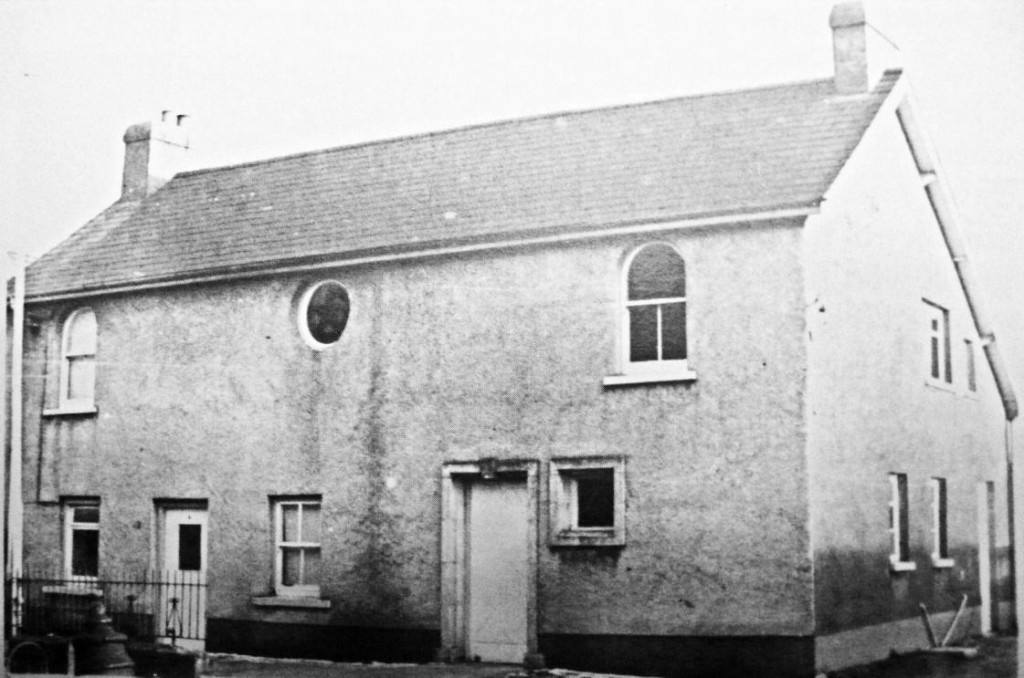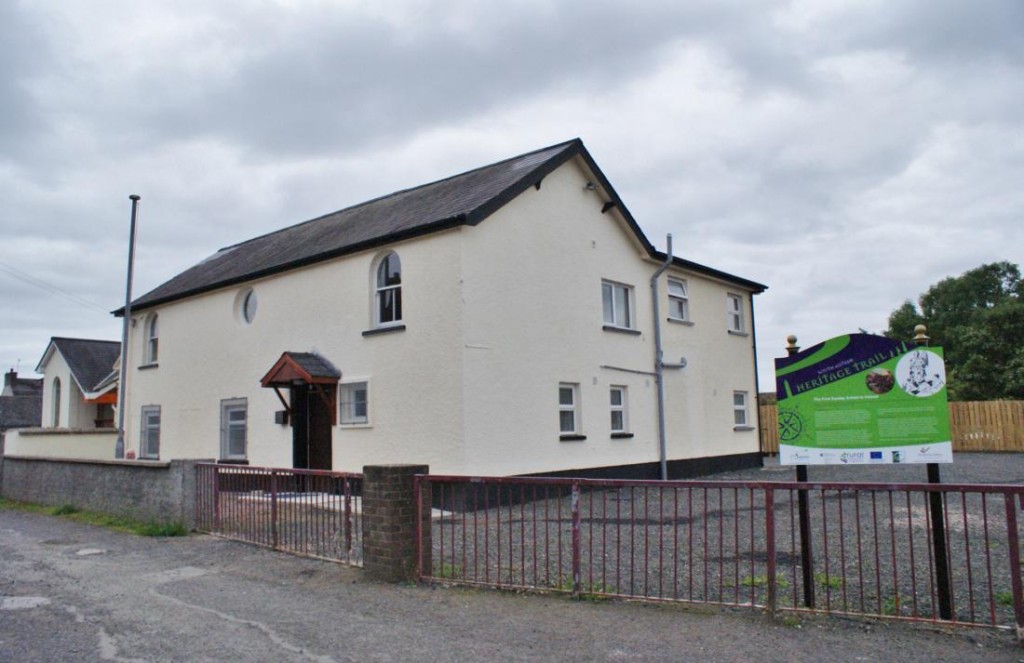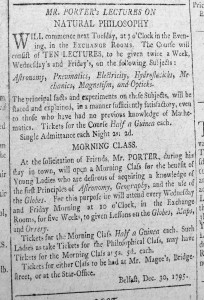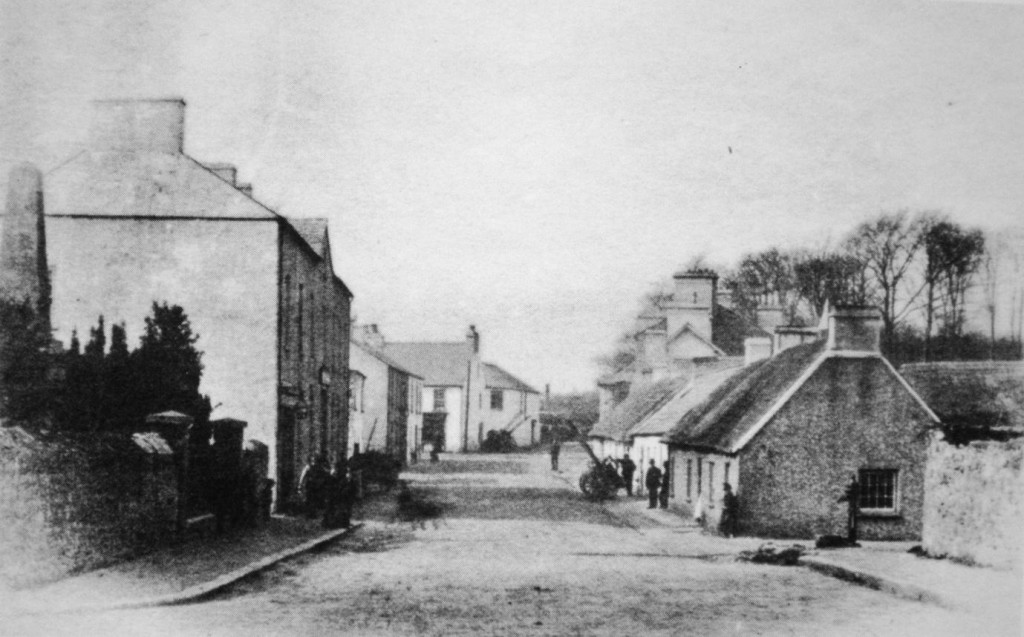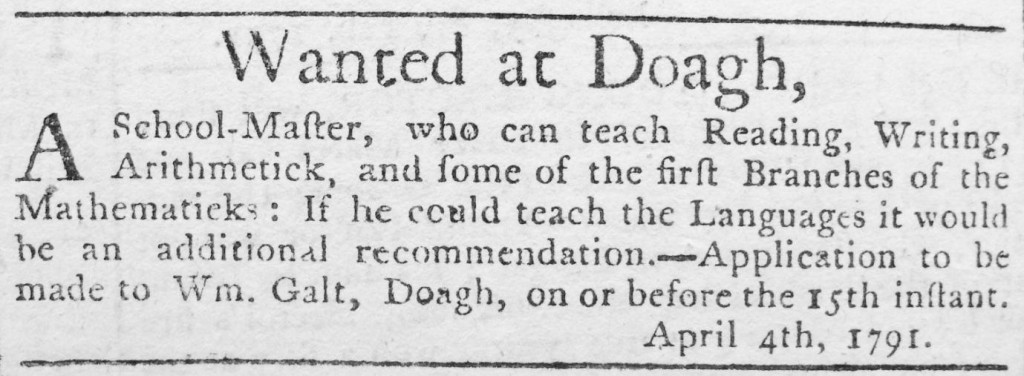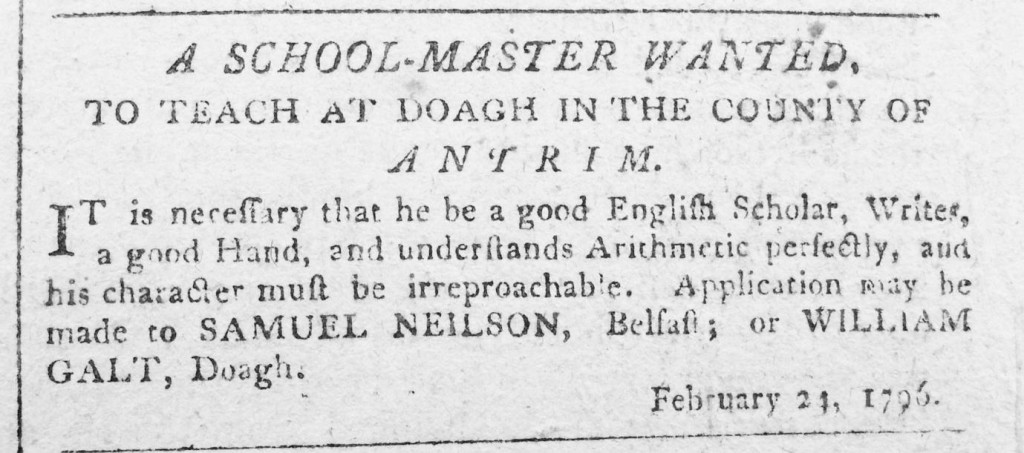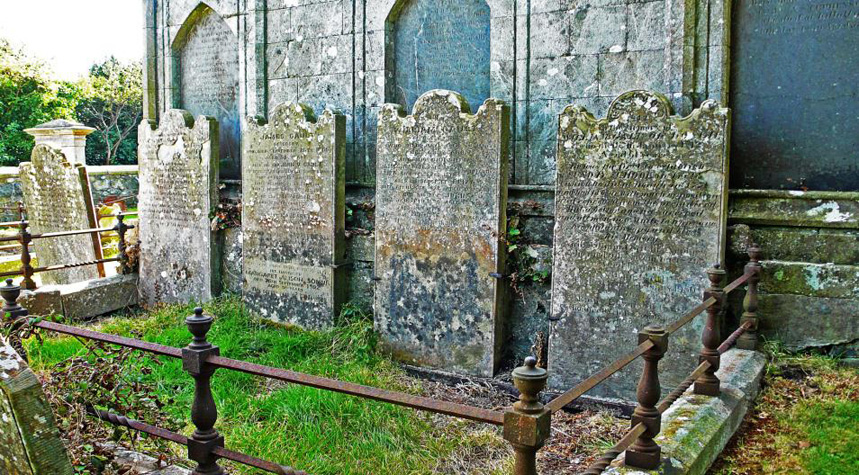“Amongst the many institutions which have arisen in this country and which have tended so materially to civilise the rural population of the North of Ireland, none stands so conspicuously pre-eminent as Reading Societies …
… The most conspicuous and the earliest society of the kind, in this part of the county, is that of Doagh”. 1
The year 2012 marks the bicentennial of the death of a remarkable but almost forgotten resident of Doagh. William Galt was born in the middle of the 18th century and died 7th January 1812. His gravestone stands in Kilbride Cemetery and testifies to the esteem in which he was held and to his philanthropic efforts.
Whilst still a young man William Galt, who was then the Schoolmaster of the village was inspired with the notion of forming a book club and was supported in this endeavour by like-minded, enthusiastic men. In 1768 the Reading Society was established and had thirty members. Their objective appears to have been to promote the mutual attainment of knowledge. They purchased and read books covering a wide range of subjects eg literature, science, history, mechanics, divinity etc. They also acquired a pair of 18 inch globes. Together as a Society the members had the opportunity to acquire what would have been beyond their reach as individuals. The desire for knowledge spread throughout the countryside and several reading societies similar to that in Doagh were formed in Ballyclare, Ballynure, Roughfort, Parkgate and Haytown.
Shortly after the Doagh Book Club was opened William Galt began to instruct the youth of the village and surrounding district. The subjects taught were reading, writing and arithmetic. Sunday proved to be the most suitable day, so that was the day set aside for this enterprise. According to the inscription on Mr. Galt’s gravestone in Kilbride Cemetery:
“He was the first to establish a Sunday School in Ireland which he did in Doagh in 1770.”
However, there has been some debate over the authenticity of this statement. An article appeared in the “Christian Life” newspaper 17 July 1880 entitled “An Early Sunday School in Ireland.” It described a school established in the last half of the 18th century at Bright near Downpatrick. The article had been written in 1851 by a man who had attended it and was published in the Downpatrick Recorder in that same year. The school appears to have started as a morning class in 1782 by Rev. Dr. T. Kennedy. But it was not until 1786 that the Sunday School in Bright was properly organised and open to all-comers. The writer of the article in the Downpatrick Recorder entered the school in 1786 when there were 40 scholars and 3 teachers. To this reprint of the article in the “Christian Life” an appended note was attached. This stated that the year 1776 should be substituted for 1782.
The Doagh Sunday School claims to have been established 6 years earlier than that at Bright, if the year 1776 is correct, and 12 years earlier if the original year of 1782 is correct. Also, the Doagh Sunday School was nondenominational from the onset. The writer of the article may have been aware of the existence of a Sunday School established previously to the one in Bright, as he refers to it as “an early” Sunday School and not the “first” Sunday School.2 Although it is not of vital importance which Sunday School was established first, it is of considerable interest. In the absence of proof to the contrary, it is reasonable that Doagh could claim the honour of having the first Sunday School in Ireland. The Sunday School flourished and soon the number of scholars receiving tuition increased to two hundred. The Reading Society provided the books required and the teachers gave their services free of charge.
It is not known where the Sunday School was originally held. It is indeed probable that neither the library nor the Sunday School had any permanent home until 1780. In 1780 the members of the library applied to Edward Jones Agnew of Kilwaughter for a site on which to build a schoolhouse. This was agreed and the members raised the funds required to erect a 2-storey building containing school accommodation and also a large room in which to house their library and hold meetings.
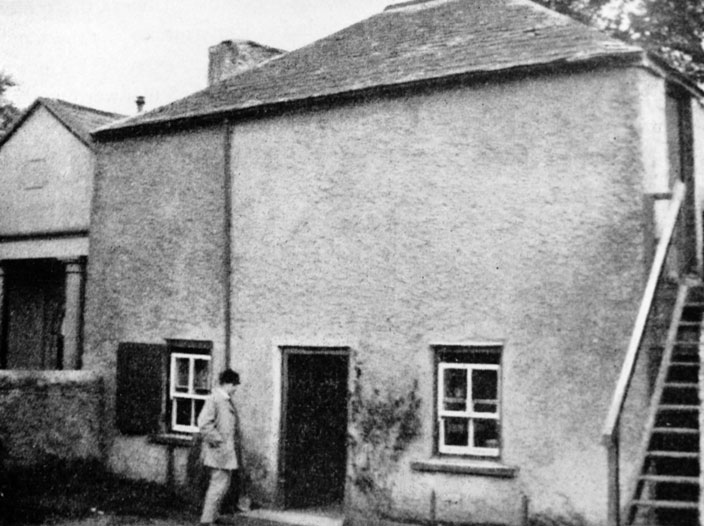
School accomodation was on the ground floor and the external stairs to the right led up to the library/assembly room.
School accommodation was on the ground floor and the external stairs to the right led up to the library/assembly room.
This building still stands beside the Methodist Church and is now known as the Doagh Community Hall, previously the Orange Hall. It was enlarged and renovated in 1958 by Mr John Thompson of Doagh and again in 2011 by Mr Thomas Downey of Toomebridge.
At this time, the residents of Doagh were active not only in literary affairs but also in political matters. This was demonstrated by the fact that during the last 30 years of the 18th century many of its inhabitants belonged to the Hearts of Steel organisation and the United Irishmen, or sympathised with their ideals.3 A group of Presbyterian businessmen met in Belfast on 14 October 1791 and formed the organisation known as the United Irishmen. A few weeks later on 20 December the Doagh Branch of the United Irishmen was established. William G. Owens was appointed Chairman and William Galt was Secretary.4
The large room which housed the library was also the venue for touring lecturers. One such person was Rev James Porter. He had been a schoolmaster before being appointed to the Presbyterian congregation of Greyabbey in 1787. He had an interest in natural philosophy and astronomy, and travelled about the country giving lectures.5 He had accumulated a considerable amount of scientific apparatus which he used to illustrate his lectures.
Mr. John Rowan wrote an article in Northern Whig in April 1874 stating that when his father (the renowned Doagh foundry owner) was eight years old he was present at one of Mr. Porter’s lectures and witnessed “an operation preformed through the electric machine on a part of the audience as they stood in a semi-circle, grasping each other by the hand, while the transitory effect of the shock passed over.”6
Mr Porter was also a strong advocate for parliamentary reform. In 1796 he wrote a series of satirical letters published in the Northern Star (“Billy Bluff and Squire Firebrand”) which antagonised, amongst others, Lord Londonderry (father of Lord Castlereagh) who was caricatured in them as “Lord Mountmumble.” Hugh Montgomery of Greyabbey was “Squire Firebrand” and a neighbouring farmer and informer named William Lowry was “Billy Bluff”. After 1796 it was suspected that he and other speakers used their touring lectures as cover for swearing in United Irishmen. He was arrested on 28 June and subsequently hanged in Greyabbey on 2 July 1798.7
In 1795 after the United Irishmen organisation was pronounced illegal those who were deemed to be United Irishmen, associated with them, or were sympathetic to their ideals, and the places where they lived or met, came under great scrutiny. In the three days after the Battle of Antrim severe retribution fell upon the towns and villages thought to be at the centre of disaffection. The yeomanry whose duty it was to hunt for ‘rebels’ were thorough in following their instructions.
“They rudely entered houses, probed under beds, into darkened corners and cupboards with their bayonets, battered in doors and lids of boxes with the butt-ends of their muskets in the hope of discovering hidden rebels and threatened people in a most domineering and abusive manner.“ 8
At that time Reading Societies were popular and in official circles, it was deemed that the desire to read was clear evidence of disaffection. There was frequent opposition to Sunday Schools also. On a marble tablet erected in the memory of Rev. William Field, a former minister of the Unitarian meeting House in Warwick , it states that amid the bitterest odium he founded the first Sunday School in that town, and maintained it in the face of almost inconceivable violence. The vicar of Warwick declared that if the school was not closed, Mr. Field’s Meeting House, and the houses of members of his congregation would be burned down. This state of feeling in an old midland town in England may go some way to explain the reference on William Galt’s headstone to the “opposition and reproach of the prejudiced.”9
The authorities evidently knew that William Galt was a rebel in spirit if not in deed. He was a pioneer in education. He was an intellectual man who took a keen interest in the political issues of the period. He was a man of considerable influence in the neighbourhood. So it is not surprising that he received more attention from the guardians of the law than most other residents in Doagh.
William Galt lived in a thatched dwelling on the corner of Main Street and Ballyclare Road. It remained as he left it on his death in 1812 until 1879 when it was renovated and considerably altered by his nephew Alexander Galt.
On one occasion as the yeomanry entered in the front of William Galt’s house he escaped at the rear. By this time he had stopped teaching and was a grocer and provision merchant.
However he continued to be very much involved in the organisation and running of the school as can be seen in the following advertisements which were placed in the Belfast News-Letter in 1791 and the Northern Star in 1796.
Along one end of William Galt’s shop was a set of meal arks (compartments for storing meal, flour etc) which were searched and the door of one was battered in with the butt-end of a musket. The battered and broken door of the meal ark was never repaired but remained as a “memento of the polite attentions Mr Galt received in 1798, until the house underwent renovations in 1879.” On another occasion they set fire to his house. However an apprentice named Kelly acted promptly and prevented its destruction. The yeomanry set fire to his house on another occasion and again the same young apprentice thwarted their efforts.
William Galt had helped to establish the library in Doagh. It was a meeting place for large groups of men thought to be United Irishmen, or at least sympathetic to them. He had set up a school and encouraged young people to seek an education. So, again it is unsurprising that the premises housing the school and library also received the attentions of the yeomanry.
In June 1798 the library, which by that time housed 1500 books, maps and a pair of 8inch globes was ransacked and destroyed by a company of Carrickfergus Fencibles. An account of this act of vandalism was recorded in Larne Literary and Agricultural Journal in 1838.
“In June of that memorable year, the library was ransacked, and destroyed by a party of the King’s troops, who proceeded in the most outrageous manner to demolish everything valuable to the Society. The books were trampled underfoot or torn asunder – the wainscoting dashed from the walls, and the globes broken to atoms. One circumstance will be sufficient to show the undignified spirit, by which the military were actuated on this occasion. A soldier, unable to destroy in an instant, a volume of Gibbon’s Decline and Fall of the Roman Empire, proceeded to kick it down the stairs, leading from the club-room to the street, when one of his comrades endeavoured to dissuade him, and calm the fury of his rage, offering at the same time to purchase the volume at its fill value; but no – this Goth would listen to no such terms, but continued to complete the business of destruction. The only work saved on this occasion, from the general wreck was Robertson’s History of Charles the Fifth, which the adjutant, who was with the party, purchased, when about a quarter of a mile out of the village, from a drummer.”10
Signed J.R.
However, an article appeared 36 years later in The Northern Whig in April 1874. In it John Rowan gives an account of a conversation he had with Samuel McSkimin shortly before his death in 1843.
“I was one of a company of Carrickfergus Fencibles who received orders to visit Doagh for the double purpose of searching for arms and arresting proscribed rebels. We entered the village, but not finding the objects searched for,those in command of the party ordered the doors of the Club Room to be burst open; and the work of demolition at once commenced. The windows and the entire furniture of the house were broken in pieces; a pair of elegant new globes smashed to atoms; the library shutters enclosing the books and papers, beaten in with musket ends, and the books thrown into the street, forming a huge pile were set fire to and burned.” “I attempted,” continued the historian, “to preserve a single volume of Robertson’s History of Charles the Fifth, which the Goth by my side perceiving, snatched away the volume, and spurned it with his foot into the flames. Never, either before or since did I return home with a heavier heart than from the disgraceful proceedings at the edifice wherein I received the first rudiments of education. Even when I reflect on this unprovoked act of devastation, I can only compare it with the deeds of Ginghis [sic] Khan or a Tamerlane.” 11
There is some discrepancy between the two articles with regard to the titles of the volumes mentioned. In the earlier account Gibbon’s Decline and Fall of the Roman Empire was burned and Robertson’s History of Charles the Fifth was saved. In the later account Robertson’s History of Charles the Fifth was burned and no mention was made of any book having been saved.
Although it may be gratifying to think that at least one of 1500 books in the library was salvaged, it is not vitally important. What is more significant is the fact that this act of destruction did not deter the supporters of the School and the library. By subscription they raised the funds needed and when it was safe to do so, they started to repair the damage. The building was restored. New globes were purchased, fresh furniture was provided, the library was replenished and additions were made from time to time. Within a few years the wreck of that devastation was no longer visible, except for the marks of musket butts on the shutters of the library.
There were 30 active members of the Book Club who paid £3 entrance and 1s 6d per quarter. The library had at least 800 volumes in its possession, including all the more important works that were popular in the 18th century. It also housed globes, scientific apparatus and ancient and modern maps. The dimensions of the school were 24 feet by 18 feet. The furniture consisted of four writing desks and six seats for readers. On an average eight could be seated on each desk or seat. In summer the school hours were 9am – 1pm and 2.30pm – 5.30pm and the average attendance was 44 boys and 27 girls. In winter the hours were 10am – 3pm and the average attendance was 30 boys and 20 girls. Saturday morning was entirely given over to religious instruction. The entire source of income for the teacher came from the scholars. They paid 2s 6d per quarter for reading, 3shs for writing and 3s 6d for calculations.
In the Ordnance Survey Memoirs 1835-39 James Boyle had this to say regarding the Doagh Book Club.
“The room on the first floor is used as a school. That on the second is tastefully and suitably fitted up with presses containing the library books. There are 40 ancient and modern maps and a capital pair of globes. The room is also used as a dancing school and dances given by the members are held in it. It is also used as a Freemason lodge room. The rules and regulations of the club are rigidly observed and it continues to prosper.”12
The library had about 800 volumes covering almost every branch of science and literature. There were 40 ancient maps around the room and a pair of very ancient large globes i.e. a celestial and a terrestrial by Jameson, purchased from London at a cost of £20. The members met quarterly to transact business and hear the report of the librarian, who gave out books required by members each week. James Love was librarian at this time and he received £2 per year, paid by the members, for the provision of this service.
The library was a centre for those with an inquiring mind and continued to prosper for many years. However, by 1850 it had ceased to flourish. The school books in use, (the school had been placed under the Board of National Education in 1832), cheap newspapers, the penny periodicals and shilling novels and indeed the famine and emigration all conspired to do what the authorities could not and the library began its downward spiral.
Some years later Rev. W.S. Smith visited the premises of the Sunday School/Library in the company of a grand-nephew of William Galt and was evidently saddened by what he experienced. He wrote:
“It is two-storied and white-washed, as indeed were most of the houses in the village. It was used from the first as a place of meeting for the Masons of the district, it is so used now. . . . . . The room in which Mr. Galt taught the Sunday School was on the ground floor and would probably seat 60 scholars. Above it we entered the apartment, in which are still the relics of the Doagh Library. I examined a number of the books, which are fast going to decay — many indeed are now almost beyond recognition. The oldest volume met with was printed in 1740 while most of those we saw were printed in the last half of the last century. . . . . . there appeared to be the best works accessible during the period in which the library flourished. . . . . . hundreds of volumes are rapidly turning to dust. The sight was a sad one. That fine library is a thing of the past – a mere memory. It had ceased to instruct, to inspire. It was in this same room that Rev James Porter occasionally lectured to the brighter intellects of the district.”13
William Galt died aged 61 years on 7 January 1812. His funeral was immense. It was preceded by the children of the Sunday School and followed by the Masonic brethren of Lodge 294. He had been a member of that Lodge for 40 years. The Club Room was the local meeting place for the Masons until they built their own Masonic Hall in 1898. The Belfast News-Letter of Friday 10th January 1812 carried the following insertion.
“In Doagh on the 7th instant, Mr William Galt aged 60 years; a man through ilfe [sic] beloved and respected. A principle object with him was the instruction of the rising generation, justly conceiving, that as knowledge increased, vice would disappear. He formed a Book Society in the year 1770 and another in 1780 which included a large proportion of the population round Doagh. In 1787, he instituted a Sunday School, where from 120 to 160 children at a time received the blessing of education. An immense concourse of people testified their respect to his memory by attending his funeral. The body was preceded by the children of the Sunday School and followed by the brethren of Lodge 294 of which he was 40 years a member. Reader, go thou and imitate his example!”14
His tombstone, which stands beside the Stephenson Mausoleum in Kilbride Cemetery, bears this inscription.
“Erected 1842 to the memory of William Galt of Doagh, who died 7th January 1812 aged 61 years. He was the first to establish a Sunday School in Ireland (which he did at Doagh in 1770) and had to bear much opposition and reproach from the prejudiced. But a better age has arrived and all men now unite to approve his philanthropy and bless his memory.”
A tribute to his memory, inspired by respect, gratitude and esteem, was written by John Alexander who had been a scholar in William Galt’s Sunday School. It is entitled: “An Acrostic Elegy”.
With feeling hearts, our loss we do lament,
In earth he’s laid, but we must be content;
Lov’d by us all, yet God’s will must be done;
Let his example show us vice to shun.
In virtue’s paths he teach’d us for to go,
All men to love, and none to make our foe;
Much trouble took this golden rule to show.
Great was his soul, in knowledge had great store,
Affliction with great Fortitude he bore;
Life spent like his, rewarded sure must be—
To this all men of knowledge doth agree.
Dispos’d he was the ignorant to instruct,
Our Sunday School with wisdom did conduct;
All means he took the poor should never miss:
God now has pleased to call his soul from this
Home to the mansions of eternal bliss!
It is superscribed: “By a Scholar of Doagh Sunday School.”
No doubt there are many people who, as inscribed on his headstone, have cause to “bless his name”. A few of the more renowned are as follows.
In 1824 John Rowan built a foundry in Doagh. He was a self-taught mechanic and his 16 workmen including his 3 sons all served their apprenticeships to him. He was responsible for building the first steam coach in Ireland. He also invented and patented the piston ring. He acquired his taste for mechanics and his knowledge of mechanism solely from the Doagh Library.15
John Alexander, (McCalshander) who composed ‘An Acrostic Elegy’ was a local poet, a member of the Doagh Book Club, an Irish Volunteer and Freemason. He amassed a miniature museum containing antiquities found in the area. He published a rhyming catalogue of his collection in Rushlight which was a weekly magazine edited by Luke Mullan Hope (father of Jemmy) from December 1824 to September 1825 when it ceased. He died 10 December 1824 in his 64th year and is buried in Kilbride Cemetery.
Samuel McSkimmin was born in 1775 in the neighbourhood of Doagh and received his early schooling in the Doagh Sunday School. He moved to Carrickfergus in 1797 and had a grocery business in the Irish Quarter. He was a member of the Carrickfergus Fencibles who attacked and destroyed the library in 1798. He was a notable historian and wrote articles for various magazines and newspapers. He is noted primarily for his “History of Carrickfergus” and “Annals of Ulster”. He died 21 February 1843 and is buried in St. Nicholas’s Churchyard in Carrickfergus.
References
- 1 Ulster Journal of Archaeology, 2nd series, vol.15 (1902)
- 2 Rev.W.S.Smith, Doagh and the First Sunday School in Ireland, pp10-11
- 3 Ibid., p2
- 4 Samuel McSkimmin, The Annals of Ulster,or Ireland Fifty Years Ago, p13
- 5 A.T.Q.Stewart,The Summer Soldiers, p272
- 6 Northern Whig Newspaper, 17 April 1874
- 7 Charles Dickson, Revolt in the North, pp189-192
- 8 Rev. W.S.Smith, Doagh and the First Sunday School in Ireland, p5
- 9 Ibid., p7
- 10 Larne literary and Agricultural Journal 1838
- 11 The Northern Whig, 17 April 1874
- 12 O.S. Memoirs of Ireland, vol.29, p74
- 13 Rev. W.S.Smith, Doagh and the First Sunday School in Ireland, p9
- 14 Belfast News-letter, 10 January 1812
- 15 O.S.Memoirs of Ireland, vol 29, p72
Sources
- Charles Dickson, Revolt in the North : Antrim and Down in 1798
- A.T.Q. Stewart, The Summer Soldiers: The 1798 Rebellion in Antrim and Down
- Samuel McSkimmin, Annals of Ulster: From 1790 to 1798
- Rev. W. S. Smith, Doagh and the “First” Sunday School in Ireland
- Rev. R. R. Cox, History of Kilbride
- Robert M. Young, Ulster in ’98 : Episodes and Anecdotes
- Rev. James Porter, Billy Bluff and ‘Squire Firebrand: or, a sample of the times, as it periodically appeared in the Northern Star.
- Jonathan Bardon, A History of Ulster
- Robert Armstrong, Through the Ages to Newtownabbey
- O.S. Memoirs of Ireland : Volume 29
- Belfast News-Letter
- Northern Star
- The Northern Whig
- The Rushlight
- Ulster Journal of Archaeology : 2nd Series Volume 15, pp158-60
- Larne Literary and Agricultural Journal, 1838
